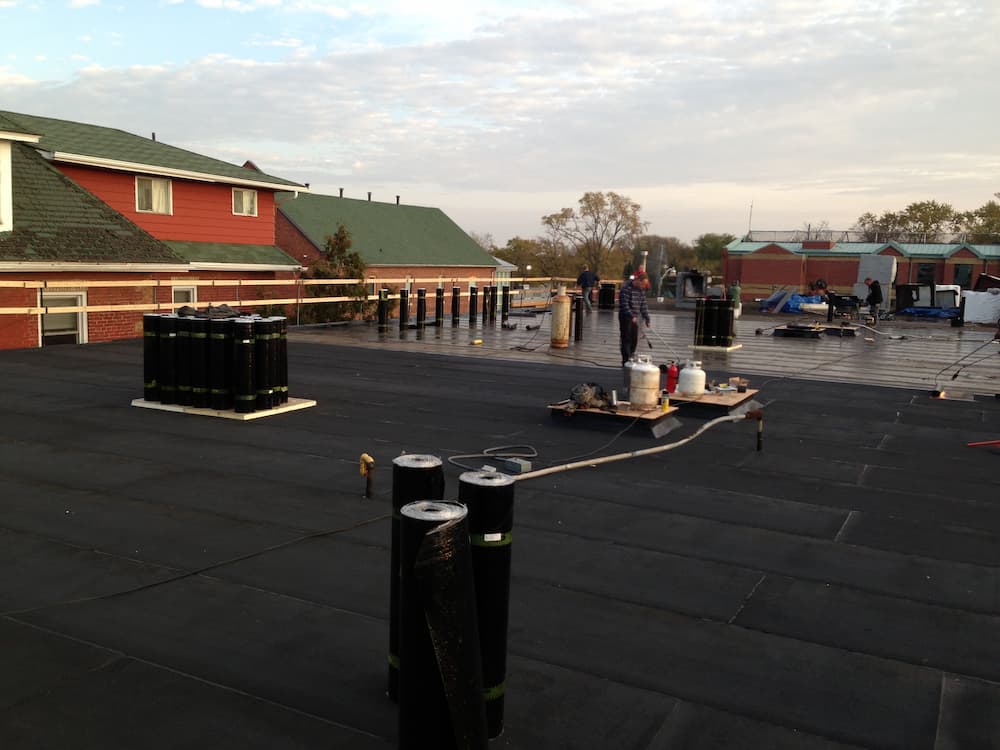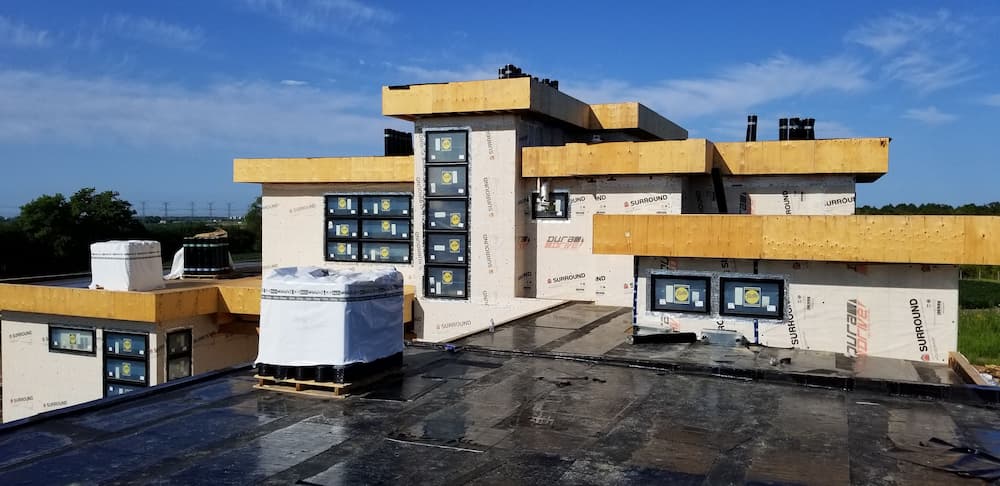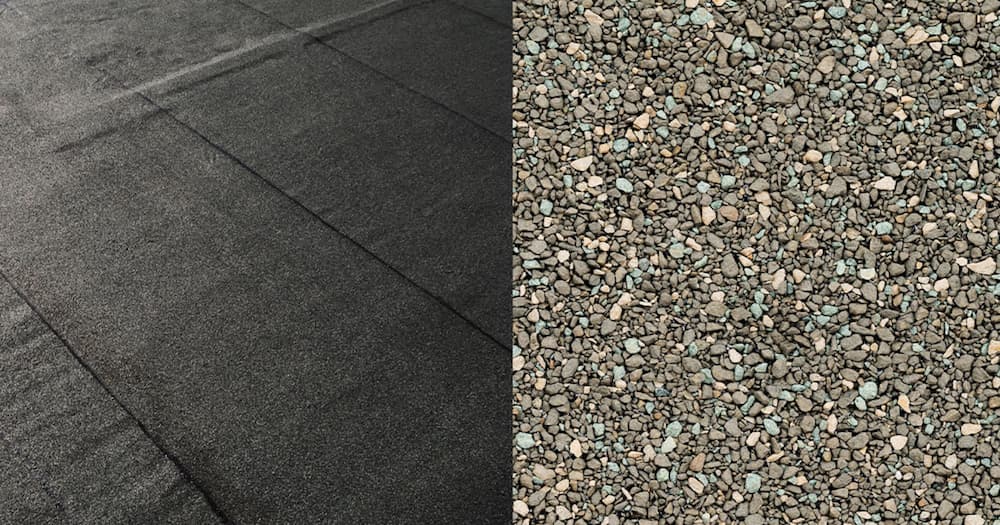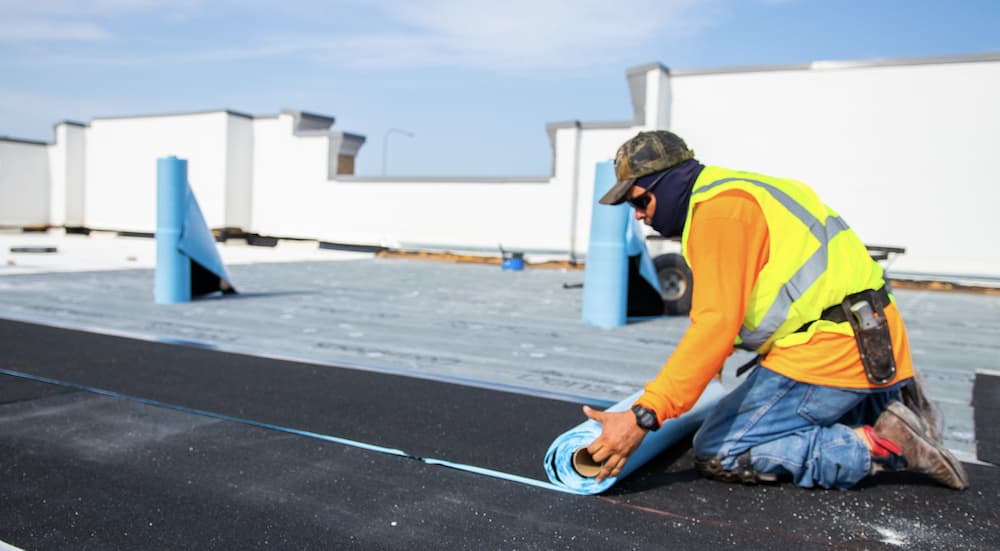Gravel and Tar Roof Installs: The Ultimate Guide
When it comes to flat roofing, there are a lot of choices out there. But if you’re looking for a durable, long-lasting flat roof option, a gravel and tar roof is the way to go. A tar and gravel roof is especially well-suited to this type of roofing, as the gravel provides an extra layer of protection against the elements.
It is installed in layers, with the first layer being a base of asphalt or tar. This is followed by a layer of gravel, which protects the asphalt from UV damage and weathering. The gravel also provides a level of insulation, keeping your home cooler in the summer and warmer in the winter.
What are tar & gravel roofs or “built-up roofs?”
A tar and gravel roof, also known as a built-up roof (BUR), is a type of roofing system that consists of multiple layers of material bonded together with asphalt or tar. The most common materials used in tar and gravel roofs are felt paper or fibreglass mats, which are then covered with asphalt or tar and topped with gravel.
Asphalt and fibreglass are applied with heat, which bonds them together. This creates a robust, durable roofing system that is resilient to weather and wear. Tar and gravel roofs are often used on commercial buildings but also on residential homes.
The BUR requires different weight loads depending on the climate. In warm climates, a minimum of four plies is recommended; in cold climates, a minimum of six plies is sufficient to protect the building.
The top layer of a tar and gravel roof is gravel, which protects the underlying layers from UV rays and weather damage. The gravel also provides a slip-resistant surface. Tar and gravel roofs can last for 20-25 years with proper maintenance. However, the lifespan can be reduced if the roof is not adequately cared for or it experiences severe weather conditions.
Tar and gravel roofs are also energy-efficient, especially when compared to traditional shingle roofs. The gravel on the top layer of the roof reflects heat, which helps keep the building cooler in the summer. This roofing system has been used for centuries and is still one of the most popular choices for commercial and industrial buildings today.
Types of built-up roofs
You can select between two types of BUR systems, modified bitumen, a composite of rubber and asphalt covered with gravel on top for durability, and ballast tar and gravel system, which is suitable for areas with readily available ballast such as crushed stone. Both styles are suitable for commercial roofing, but the former is more commonly used. Modified bitumen roofs are available in different thicknesses and can be reinforced with polyester or fibreglass for additional strength. They are also less susceptible to leaks and tears.

Modified bitumen roofs
Modified bitumen roofing systems consist of an asphalt-impregnated base layer covered with a layer of gravel. Modifiers are added to the roofing asphalt to replace traditional petroleum-based solvents and plasticizers, making the asphalt more flexible and resistant to tears and leaks.
Fibreglass mating is the most common reinforcing material used in modified bitumen roofs. It is available in different weights and can be applied in various ways, including torch-down, cold-applied, and self-adhered. Polyester matting can also be used, though it is not as common.
Modified bitumen roofs are available in various colours, though black is the most popular choice. They can also be applied in different thicknesses, depending on the needs of the building. The most common type of modified bitumen roofing is atactic polypropylene (APP), and styrene-butadiene-styrene (SBS) modified bitumen. SBS-modified bitumen is made with a plasticizer that makes the asphalt more flexible, enhancing its capacity for expansion and contraction
APP-modified bitumen contains a rubber modifier that makes the asphalt more resistant to tears and leaks, improving its ability to maintain strength as it ages. An expert roofing contractor in your area will be able to guide you on the best option for your house since each type is popular in various climates and regions.
Ballast tar & gravel roofs
A ballast tar and gravel system might be the best option if you like the larger stones’ aesthetic feel and appearance on top of your commercial roof. This system is also known as mechanically attached gravel surfacing and is ideal for locations with an abundance of ballast, such as crushed stone. The best thing about this system is that it is exceptionally durable and can last many years with little to no maintenance.
Mechanically attached roofs are fastened to the roof deck with screws and plates. The ballast is then placed on top of the membrane and held with wires or nets (optional). This system is less common than the modified bitumen roofing system due to its heavy weight.
Ethylene propylene diene monomer (EPDM) is the most common type of membrane used in ballast tar and gravel roofs. Other alternatives are thermoplastic polyolefin (TPO) and polyvinyl chloride, which are also suitable. The ballast can be either smooth or angular, though the latter is more common as it provides a better grip.

Why install a BUR flat roofing system?
So why should you use a tar and gravel roofing system over other types of flat roofs? Several reasons make this system the best choice for commercial and industrial buildings.
- The gravel on the top layer of modified bitumen roofs protects the underlying layers from damaging UV rays and weather conditions. The gravel also offers a slip-resistant surface.
- The gravel absorbs heat, which helps keep the building cooler in the summer. It also releases heat and enhances water evaporation, keeping moisture away from the building and reducing the chances of condensation and mould growth.
- Keeping the gravel evenly distributed on the roof surface is essential to maintaining its energy-efficient properties. The gravel should be replaced every few years to maintain its effectiveness.
- This roofing system can last up to 30 years with proper maintenance. However, the lifespan can be reduced if the roof is not adequately cared for or it experiences severe weather conditions.
- Tar and gravel roofs are also energy-efficient, especially when compared to traditional al shingle roofs. The gravel on the top layer of the roof reflects heat, which helps keep the building cooler in the summer. This roofing system can also help reduce utility costs by up to 30%.
- Tar and gravel roofs are also very easy to install and repair. This system can be installed on any roof deck, including wood, concrete, metal, and asphalt.
The maintenance requirements of a BUR roof
Like all flat roofing systems, tar and gravel roofs require regular flat roof maintenance to ensure they last for many years. The gravel on the top layer of the roof needs to be replaced every few years to maintain its energy-efficient properties. The roof should also be inspected regularly for any signs of damage, leaks, or wind damage.
The roof is reinforced or strengthened by putting additional layers of fibreglass mat or polyester fabric over the membrane of the existing roof. This is an effective method to prevent any future leaks.
Regularly cleaning the roof is also essential to remove any dirt, debris, or leaves that can clog the drainage system. Keep an eye on pooling water, as it can damage the roof and lead to leaks.
If you notice any signs of damage, it is important to have the roof repaired as soon as possible to prevent any further damage. It is also important to have the roof inspected by a professional every few years to ensure it is in good condition.

Repairing flat roofing systems
Even though BUR last for decades, chances are you will have to do some repairs on your roof at some point. The most common reason for roof repair is ponding water, which can cause the gravel to shift and expose the tar membrane. If you notice any exposed areas, addressing them as soon as possible is important to prevent damage.
Other causes of roof damage include:
- Extreme weather conditions such as hail or wind storms
- Drainage problems
- Poor installation
- Trees or other vegetation rubbing against the roof
- Animals or birds nesting on the roof
- Improper installation or maintenance
Various types of BURs have different methods of repair. For example, you heat the damaged area with a mod bit roof and then apply a cold process adhesive. You would remove the gravel in the damaged area with a claimed roof and then apply a hot asphalt mastic. Water and moisture build-up is the main reason for repair with a gravel roof.
It is important to note that a professional roofing contractor should only do roof repair. Attempting to repair yourself could result in further damage to your roof or injury to yourself.
When choosing a roofing contractor, ask about their experience with repairing tar & gravel roofs. It is also important to get a written estimate of the cost of the repair before work begins. This will help avoid any surprises down the road.
Once the repair is complete, have the contractor inspect the rest of your roof to ensure there is no other damage. It is also a good idea to have your roof inspected annually by a professional to prevent minor problems from becoming big ones.
When do you say “NO” to a BUR roof?
There are certain situations when a tar and gravel roof is not the best option. While this system is durable and long-lasting, there are some situations where another roofing system would be a better choice. Here are some conditions that are not ideal for BUR:
- Areas with a lot of rainfall or snow: The gravel on top of the tar can act as a barrier against water, but it is not impenetrable. Over time, the weight of the water can cause the gravel to shift and expose the tar membrane. Extreme precipitation and snow or ice accumulation can also cause the tar to crack. A different roofing system will be a better option if your building is located in an area with high rainfall or snowfall.
- Building with a lot of foot traffic: If there will be a lot of foot traffic on the roof, consider another roofing option. The gravel can shift underfoot and expose the tar membrane, leading to leaks.
- A place with intense sun exposure: Extreme heat can cause the tar to soften and become less effective. The membrane is destroyed by ultraviolet (UV) rays, which causes it to become brittle and crack. Consider another roofing option if your building is exposed to direct sunlight for long periods.
- Buildings with HVAC units: The vibration from the HVAC unit can cause the gravel to shift, especially when the unit is turned on and off frequently. The shifting gravel can expose the tar membrane and cause leaks.
Get the most from your flat roof investment
A tar and gravel roof is a significant investment for your building. A maintenance plan is vital in ensuring that your roof lasts for decades. A good maintenance plan includes regular inspections and repairs as needed. The key is to have a plan and stick to it to prolong the eventual replacement of your flat roof.
One of the most effective ways to extend the lifetime of your tar and gravel roof is to have it regularly cleaned. The gravel on top of the tar can trap dirt, leaves, and other debris. This build-up can cause the roof to deteriorate prematurely. A professional roofing contractor can clean your roof and remove any build-up. It is also important to clear any debris that has accumulated on the roof. Debris, such as leaves and twigs, can hold moisture against the roof and cause the tar to deteriorate.
Documenting and maintaining a schedule of your roof’s care and maintenance is essential to sustain its longevity. You will have proof of the work that has been completed and when it was done. This will come in handy if you ever need to file an insurance claim or warranty claim.
The condition of your roof can also be used as a negotiating tool when it comes time to sell your building. Potential buyers will be impressed by the condition of the roof and the documentation of the care taken. This can be used to your advantage when negotiating the selling price.


